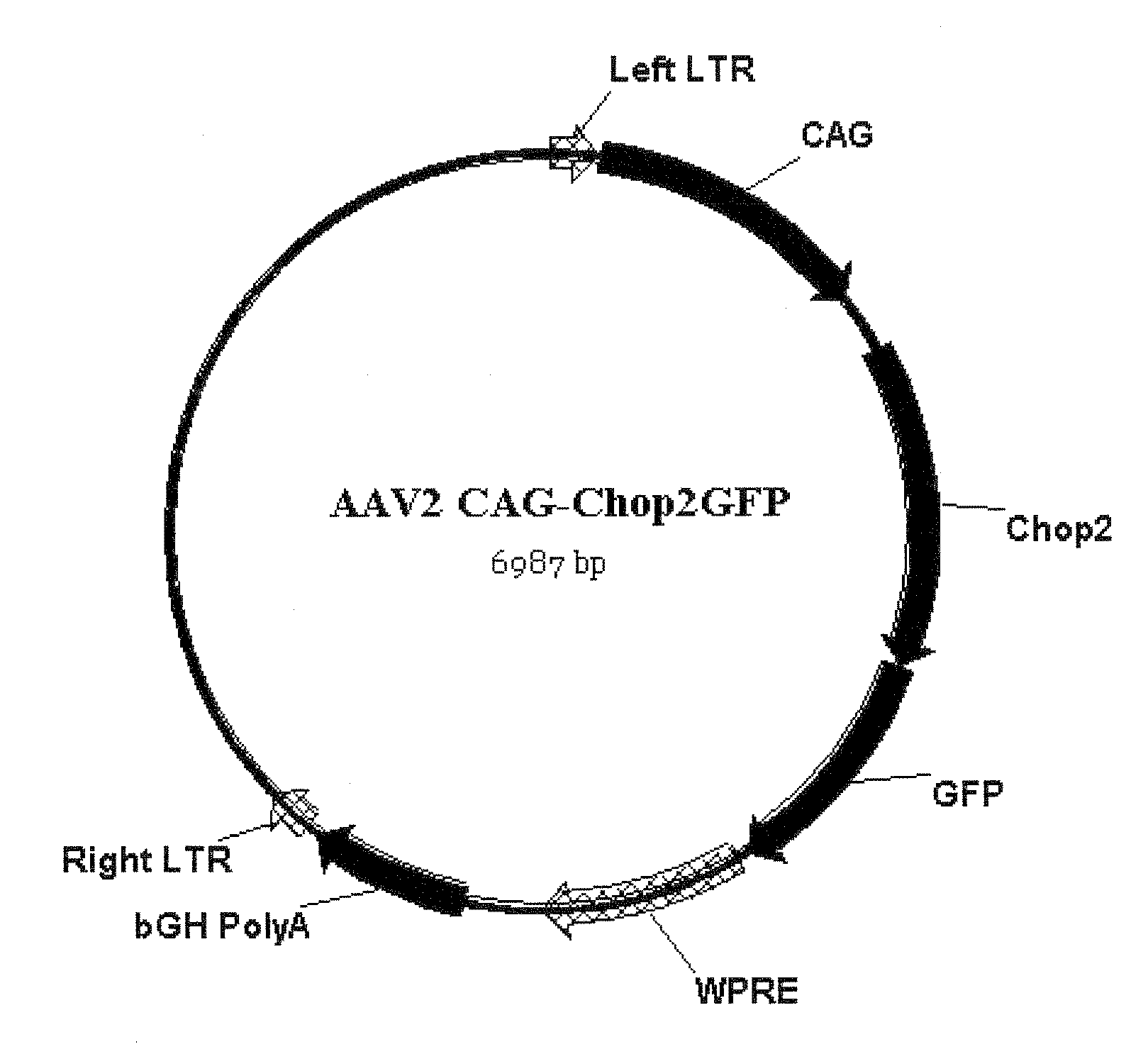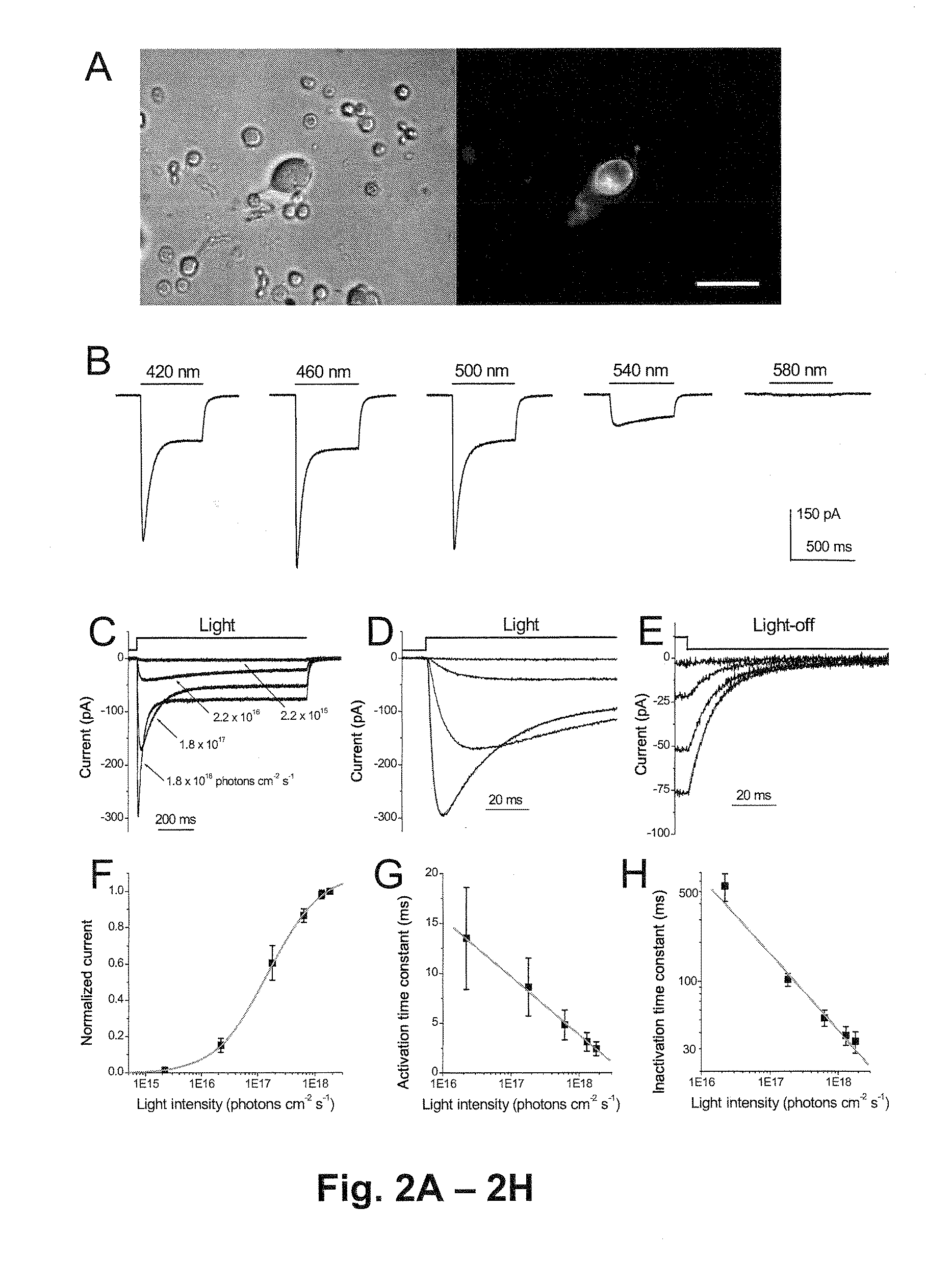Restoration of visual responses by in vivo delivery of rhodopsin nucleic acids
a rhodopsin and nucleic acid technology, applied in the field of molecular biology and medicine, can solve the problems of severe visual impairment in the centrally, no effective treatment or cure, complete blindness, etc., and achieve the effects of restoring visual evoked responses, restoring light sensitivity to the retina, and producing robust membrane depolarization or action potential firing
- Summary
- Abstract
- Description
- Claims
- Application Information
AI Technical Summary
Benefits of technology
Problems solved by technology
Method used
Image
Examples
example i
Materials and Methods
DNA and Viral Vector Constructions
[0172]The DNA fragment encoding the N-terminal fragment (Met1-Lys315) of Chop2 (Nagel et al., 2003) was cloned into pBluescript vector (Stratagene) containing the last exon of a mouse protamine 1 gene containing polyadenylation signal (mP1) and GFP cDNA inserted in frame at the 3′ end of the Chop2 coding fragment to produce a Chop2-GFP fusion protein. The function of Chop2-GFP chimera was verified in transfected HEK293 cells.
[0173]The viral expression construct rAAV2-C AG-Chop2-GFP-WPR E was made by subcloning the Chop2-GFP fragment into an adeno-associated (serotype-2) viral expression cassette. The viral cassette comprised a hybrid CMV enhancer / chicken β-actin promoter (CAG), a woodchuck posttranscriptional regulatory element (WPRE), and a bovine growth hormone (BGH) polyadenylation sequence. Viral vectors were packaged and affinity purified (GeneDetect).
[0174]The vector map is shown in FIG. 7.
[0175]The nucleic acid sequence o...
example 2
Expression of Chop2 in Retinal Neurons In Vivo
[0198]To directly visualize the expression and localization of Chop2 proteins, the C-terminal portion of the Chop2 channel was replaced with GFP, to make a Chop2-GFP chimera. The adeno-associated virus (AAV) vectors was selected to target the expression of Chop2-GFP fusion protein into retinal neurons because the capability of AAV vectors to deliver transgenes into nondividing cells, including inner retinal neurons (Harvey et al., 2002 and Martin et al., 2003), and to integrate the transgenes into the host genome (Flotte, 2004).
[0199]A viral expression cassette, rAAV2-C AG-Chop2-GFP-WPRE, was made by subcloning the Chop2-GFP chimera into an AAV serotype-2 expression cassette containing a hybrid CMV enhancer / chicken β-actin (CAG) promoter (FIG. 1A). To establish the expression and function of Chop2 channels in retinal neurons in general, we first examined the expression of Chop2 in nondystrophic retinas. The viral vector was injected into...
example 3
Properties of Light-Evoked Currents of ChR2-Expressing Inner Retinal Neurons
[0202]Functional properties of the Chop2 channels were examined in inner retinal neurons by using whole-cell patch-clamp recordings. The recordings were performed in acutely dissociated cells so that photoreceptor-mediated light responses were confidently excluded. Chop2-GFP-positive cells were identified by their GFP fluorescence (FIG. 2A). The precursor for the Chop2 chromophore group, all-trans retinal, was not added because it might be ubiquitously present in cells (Kim et al, 1992 and Thompson and Gal, 2003). Light-evoked responses were observed in all recorded GFP fluorescent cells (n=34), indicating that functional ChR2 (Chop2 with the chromophore attached) can be formed in retinal neurons with the retinal chromophore groups already present in the cells. Consistently, the expression of functional ChR2 channels has also been recently reported in cultured hippocampal neurons without the supply of exogen...
PUM
| Property | Measurement | Unit |
|---|---|---|
| Time | aaaaa | aaaaa |
| Biological properties | aaaaa | aaaaa |
| Sensitivity | aaaaa | aaaaa |
Abstract
Description
Claims
Application Information
 Login to View More
Login to View More - R&D
- Intellectual Property
- Life Sciences
- Materials
- Tech Scout
- Unparalleled Data Quality
- Higher Quality Content
- 60% Fewer Hallucinations
Browse by: Latest US Patents, China's latest patents, Technical Efficacy Thesaurus, Application Domain, Technology Topic, Popular Technical Reports.
© 2025 PatSnap. All rights reserved.Legal|Privacy policy|Modern Slavery Act Transparency Statement|Sitemap|About US| Contact US: help@patsnap.com



